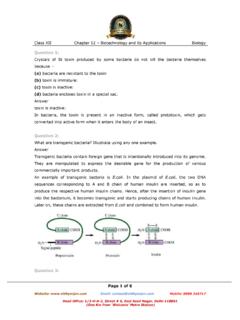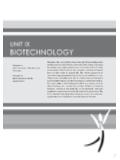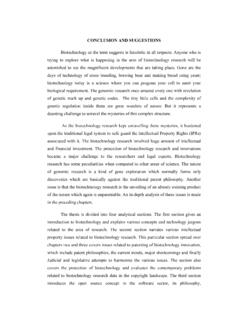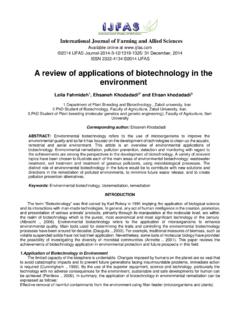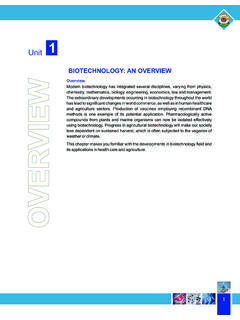Transcription of US Environmental Protection Agency Biotechnology Algae …
1 US EPA, August 5, 2015 US Environmental Protection Agency Biotechnology Algae Project Purpose. The United States Environmental Protection Agency (EPA) is developing a project to support public dialog concerning the development and use of Biotechnology . One emerging technology over which EPA has oversight responsibility is the production and use of intergeneric cyanobacteria, eukaryotic microalgae and their products by application of genetic engineering approaches. It is around these Biotechnology Algae applications that EPA is focusing its project.
2 Background. Under the Toxic Substance Control Act (TSCA), EPA provides technical support for those who must report to EPA on new chemical substances and microorganisms that are not yet in commerce. In 1997, EPA promulgated the Microbial Biotechnology Rule which implemented rules for new microorganisms under TSCA. Connected with this effort and also in 1997, EPA revised its document, Points to Consider in the Preparation of TSCA Biotechnology Submissions for Microorganisms (Points to Consider). Use of the Points to Consider assists those who intend to submit pre-manufacture Microbial Commercial Activity Notices (MCAN) or TSCA Experimental Release applications (TERA) for various commercial products.
3 The document helps submitters identify and organize the information and data they provide to inform EPA s required risk Project Description. EPA is currently updating the Points to Consider to accommodate the development of new information relevant to risk assessment of Biotechnology products regulated under TSCA. This document currently identifies a broad range of risk assessment topics relevant to TSCA Biotechnology submissions, providing technical support to assist those who must prepare microorganism premanufacturing notifications to EPA under TSCA.
4 Those Points to Consider do not currently provide specific support for those using the emerging technologies of Algae production and Biotechnology . To keep its risk assessment process for Biotechnology Algae open and transparent, EPA intends to develop a separate document on the scientific and technological issues it currently understands to be key and unique for evaluating risks from the production and use of Biotechnology Algae . EPA will develop its Considerations for Biotechnology Algae document in parallel with updating the Points to Consider document.
5 The updates to the Points to Consider will be enhancements of the current detailed, how-to content for submitters to think about as they prepare submissions. The current document is organized in a way to reflect the components of risk assessments for microorganisms, but the format is not optimally designed to deal with specific considerations informing the evaluation of Biotechnology or algal technologies submitted under TSCA. For example, using the current structure would distribute the guidance on how to prepare Biotechnology or algal technology applications among various sections.
6 As such, there would not be explicit sections in the update assigned to a specific technology. The Considerations for Biotechnology Algae , being a separate, stand-alone document, can organize the information in a consolidated manner that can assist those developing new microbial technology applications that have emerged since the last revision of the Points to Consider. Even those applications that employ both algal and genetic engineering technologies simultaneously can be highlighted in a way 1 EPA's Biotechnology regulations provide exemptions limited to specified recipient microorganisms and introduced genetic material that is limited in size, well-characterized, poorly mobilizable, and free of certain sequences.
7 A "Tier I" exemption requires certain certifications and recordkeeping, while the "Tier II" exemption requires certain certifications and a notification to EPA and EPA review of specific physical containment and control technologies. US EPA, August 5, 2015 that the current Points to Consider cannot readily do. This separate Biotechnology Algae document can also serve other purposes, unlike the Points to Consider, which is primarily designed to assist submitters of notifications under TSCA. The Considerations for Biotechnology Algae document, besides being a resource for MCAN and TERA submitters, can also through its use as an example of an actual, practical governance tool help advance discourse around broader societal implications of Biotechnology .
8 Once fully developed, it will be a source of information that could be folded into the Points to Consider, within its current structure or in other ways, such as an addendum, or it could remain as a stand-alone complement to the Points to Consider. EPA expects that the process of revising the Points to Consider and developing a companion document on considerations for Biotechnology Algae will lead to the identification of technical, Environmental and social science research needs related to the introduction of such products into society.
9 Addressing these research needs may directly or indirectly support EPA s evaluation of such products under TSCA, as well as more broadly help advance the responsible development and application of Biotechnology . Therefore, as EPA develops its considerations document for Biotechnology Algae , it welcomes public input not only on technical Environmental assessment issues, but also on the societal benefits and implications of Biotechnology Algae products. EPA will facilitate such engagement by holding an expert workshop, open to the public, during the week of September 28, 2015.
10 While this workshop will focus on the technical questions that EPA believes are important to its development of a Biotechnology Algae considerations document, it will also provide an opportunity to stakeholders and the general public to comment on any aspects of Biotechnology Algae they believe are relevant to EPA s mission. Following the workshop, EPA will consider the public input as it begins to draft its Biotechnology Algae considerations document. EPA expects that feedback on the Biotechnology Algae document also will inform the update of the Points to Consider document.










